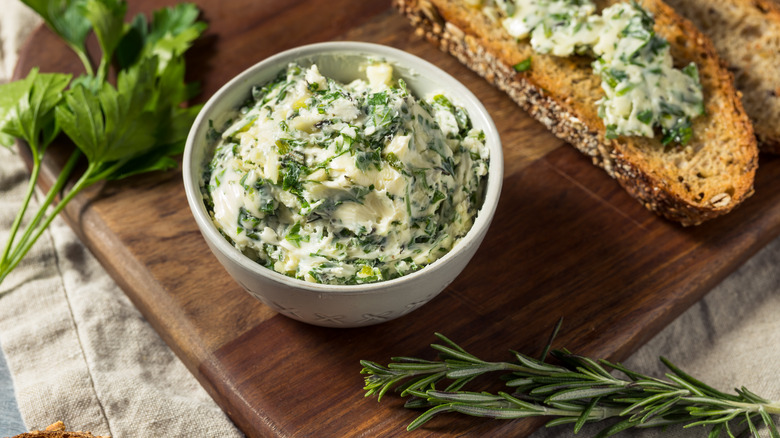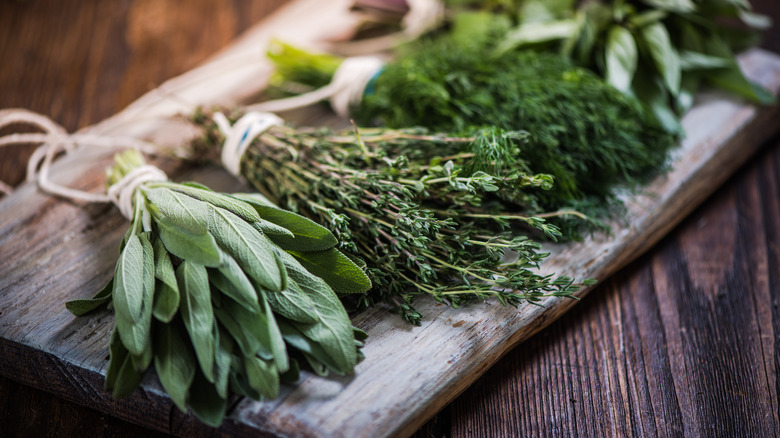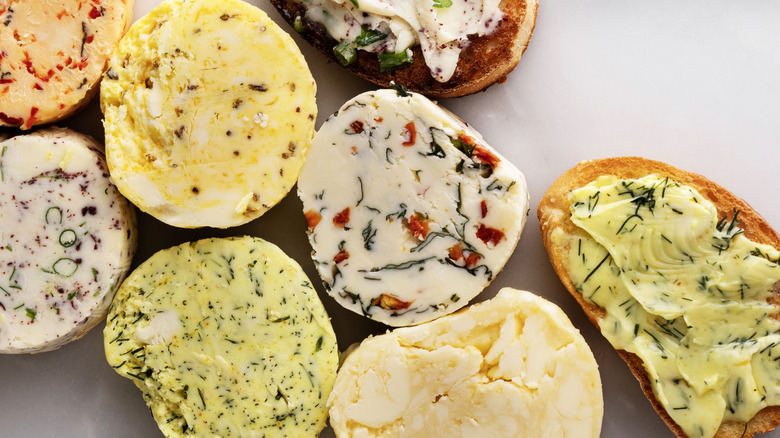The Cooking Tip To Remember For A Fresh Herb Blend With Butter
Butter is a wondrous thing: It tastes amazing on its own, adds a voluptuous richness to dishes, makes for a terrific non-stick oil once it clarifies, and can be an ideal carrier for many other flavors. Butter mixed with anything — garlic, shallots, spices, or herbs — is known as compound butter. Almost every compound butter recipe tells you to bring the butter to room temperature and mash everything else into it. Sure, this works. But, especially when dealing with fresh herbs, melting the butter and adding minced herbs over low heat will really enhance and extend the flavor of the herbs' aromatic oils. Remember this when making a fresh thyme compound butter to top that perfectly grilled filet mignon.
To get technical about it, butter is a solid, or saturated, fat, meaning it stays solid at room temperature. A cold stick of butter fresh from the fridge is far too cold to use as a carrier for any other ingredients, so you must (at least) soften it at room temperature before making a compound butter. Take that temperature a little higher –- to only 90 or 95 degrees Fahrenheit — and the butter will melt, allowing for a more comprehensive absorption of aromatic oils.
Herb, meet butter
In practical terms, here's how to make an amazing herb butter: Cut a stick of unsalted butter into many slices and place it in a saucepan over a low heat. Your goal isn't to cook the butter at all; you're not looking for bubbles or foam or anything else that would suggest clarification. Then, stir in the minced, fresh herb(s) of your choice and keep the pan on the heat for a minute or two. Once the herbed butter cools back down to room temperature, scrape it onto parchment paper, form it into a log shape, and refrigerate. Done and done.
You'll want to mince the herbs for a couple of reasons, the most obvious being to avoid chewing on that big ol' rosemary leaf contained in your compound butter. The other reason to mince is that it increases the herb's exposed surface area, which is why you also want to cut up that stick of butter: So it will melt more quickly. The aromatic oils of finely minced herbs will be absorbed more thoroughly by the butter's fatty acids. In fact, if you have a mortar and pestle, you might want to grind the herbs up instead of mincing them.
Balance the herbaceousness
Fresh herbs can be quite assertively flavored (and dried herbs even more so), and you can easily overdo a compound butter by adding too much of a good thing. A good rule of thumb is to add one or two tablespoons of minced herbs to every stick of melted butter. This might be less than what you might add when mashing herbs into softened butter, but remember, we're doing an infusion here. Of course, you'll figure out the best ratio for your herbed compound butter preferences in short order.
If you want to use more than one herb — and you totally should — consider three things: Which one you want to be the star of the show, the different herbs' intensity of flavors, and which go well together. Sage is quite assertive, while chervil is more delicate. Fresh rosemary can take over, but basil probably won't. In terms of pairing, Mediterranean herbs like rosemary, thyme, and marjoram adore each other. Add savory, oregano, and lavender, and you've got a classic Herbes de Provence.


